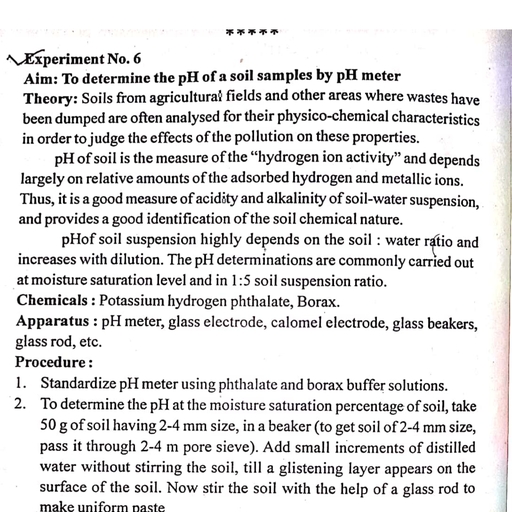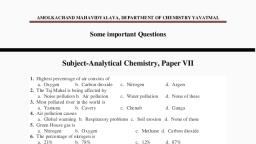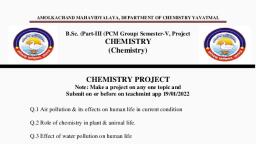Page 1 :
Exercise-JI, PHYSICAL CHEMISTRY EXPERIMENTS, , Experiment No. 1, To determine strength of given HCI solution conductometrically., , Theory: Electrolytic conductivity is a measure of the ability of a solution to, conduct electric current. Solutions of electrolytes conduct an electric current, by the migration of ions. Migration of ions depends on their charge. size,, and viscosity of the medium and the magnitude of potential gradient. Like, metallic conductors, electrolytic solutions obey Ohm’s law ( /=V//R)- The, , Suarieu- with Carr, , eat
Page 2 :
A Text Book of Practical Chemistry 9, , reciprocal of resistance, J/R is called conductance. The standard unit of, conductance is specific conductance (k). Its SI unit is Sm? but normally, reported as Scm'. It is conductance ofa cube of solution contained between, two parallel plates 1cm square, and 1 cm apart. Conductance depends on, concentration and the temperature. Equivalent conductance (1,,) increases, with decreasing concentration (increasing dilution), whereas specifics, conductance decrease with decreasing concentration. The limiting value of, conductance at zero concentration (infinite dilution) is called equivalence, conductance at zero concentration (A,) or infinite dilution (A, ), , In conductometric titrations, the determination of equivalence point, is based upon the variation of electrical conductivity of a solution during, the course of titration. The electric conductivity varies with number of ions, present and their mobility. On plotting observed conductance against the, volume of titrant added, two straight lines are obtained. The point of, intersection of the two lines gives the equivalence point. For acid- base, titrations, the nature of graph depends on what is being titrated and what is, formed in the reaction (fig 1a-1d)., , Vee, , st. acl-st base st, acid- areas base weak ae j-st. base weak acl weak base, For all condkadtesnede skperimenta, ‘conductivity jee should be, used because conductivity of a solution is influenced by the presence of, traces of foreign electrolytic impurities (that is why ordinary water is not, , suitable)., Temperature control: For precise work, conductivity of a solution must, , be measured at constant temperature because, for most of the ions, conductance increases by 2 to 3% per degree rise of temperature., , Advantages of Conductometry, i) Very dilute solutions can be titrated, i). Highly coloured solutions can also be titrated, , ii) No need of an indicator, , vuaiicu wiur VdalT
Page 4 :
A Text Book of Practical Chemistry _ mel, , ii) Add 0.1 cm? NaOH (0.1M) from micro barrette (If not available an, ordinary burette may also be used. See note after point iii). Stir well, and measure the conductance of solution. ,, , iti) Continue addition of 0.1 cm? NaOH (0.05 cm? near end point), stiring, well after each addition till 3-4 cm? NaOH is added., , Note : If you are using ordinary burette, then perform the experiment, , by taking 10 cnt’ of 0.01M HCI solution & titrate the solution by using, , 0.01 M NaOH. Add I cm? NaOH initially and then 0.2 cm? after addition, , of 7- 8 cm? NaOH. In that case calculations will change. 20 in, , denominator will be replaced by 10., , Observations : Mass of oxalic acid dissolved = w g, , , , , , , , , , , , . 4 W x10, Molarity of oxalic acid = 126, an olewwhore Mass, Table : 1) Standardization of NaOH of oxalic ocr d- S.N. Volume of oxalic acid taken Volume of NaOH required, (cm?) (cm?), 1 10, 2 10, 3 10, , , , Table 2) Variation of observed condutance, , S.N. | Volume of NaOH added (cm*) Observed conductance (S), l 10, 2 10, 3 10, , , , , , , , , , , , , , , , , , , , Graph : Plot a graph between observed conductance and volume of NaOH, added. The point of intersection gives the equivalence point., Calculations : Determine molarity of NaOH from std. oxalic acid solution., (COOH), + 2 NaOH — (COONa), + 2H,0, 1 mole of (COOH), =2moleofNaOH, , M,V, _ M,V,, n, n,, , vuaiicu wiur UdlT






























